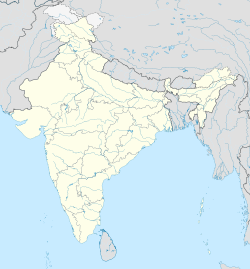Jammu
| Jammu | ||
|---|---|---|
|
|
||
| State : |
|
|
| Union Territory : | Jammu and Kashmir | |
| District : | Jammu | |
| Location : | 32 ° 44 ′ N , 74 ° 51 ′ E | |
| Height : | 313 m | |
| Area : | 112 km² | |
| Residents : | 502,197 (2011) | |
| Population density : | 4484 inhabitants / km² | |
| Website : | www.jmcjammu.org | |
| View of Jammu and the Tawi River | ||
Jammu ( Dogri : जम्मू Jammū , Urdu : جموں Jammū̃ ) isthe second largest city (since 2000 Municipal Corporation )after Srinagar in the Indian Union Territory of Jammu and Kashmir .
It has around 500,000 inhabitants, 650,000 in the agglomeration (2011 census), on an area of 20 km² and is located at an altitude of 305 m. The main colloquial language among the population is Dogri .
From November to April it serves as the “winter capital” and seat of the government of Jammu and Kashmir because of its more favorable climate. The city is an important rail and transport hub and has numerous Hindu temples. The city is actually only visited by a few tourists, as it has been the site of terrorist attacks several times in the past; the areas west of Jammu are among the most dangerous areas in India.
Jammu is 50 km from the Pakistani city of Sialkot in Punjab .
climate
Jammu, like the rest of northwestern India, has a humid subtropical climate. June is the hottest month and the average maximum temperature is 41 ° C. January is the coldest, the minimum temperatures are on average 7 ° C and sometimes below freezing point. The average annual precipitation is 1100 mm. Most of it falls from June to October, but winters can also be quite wet.
| Jammu | ||||||||||||||||||||||||||||||||||||||||||||||||
|---|---|---|---|---|---|---|---|---|---|---|---|---|---|---|---|---|---|---|---|---|---|---|---|---|---|---|---|---|---|---|---|---|---|---|---|---|---|---|---|---|---|---|---|---|---|---|---|---|
| Climate diagram | ||||||||||||||||||||||||||||||||||||||||||||||||
| ||||||||||||||||||||||||||||||||||||||||||||||||
history
Jammu was the winter residence of the Maharajas of the princely state of Kashmir and Jammu , which in India was mostly named after the Hindu-influenced Jammu, while the Europeans mostly spoke of Kashmir. Between 1867 and 1877, the State Post of the Maharajas of Kashmir and Jammu issued postage stamps under the name Jammu. The province of Jammu was around 40,000 km² around 1900 and had 940,000 inhabitants.
literature
- Andreas Birken : Philatelic Atlas of British India , CD-ROM, Hamburg 2004
- Imperial Gazetteer of India, 2nd A., 26 vol., Oxford 1908–1931

